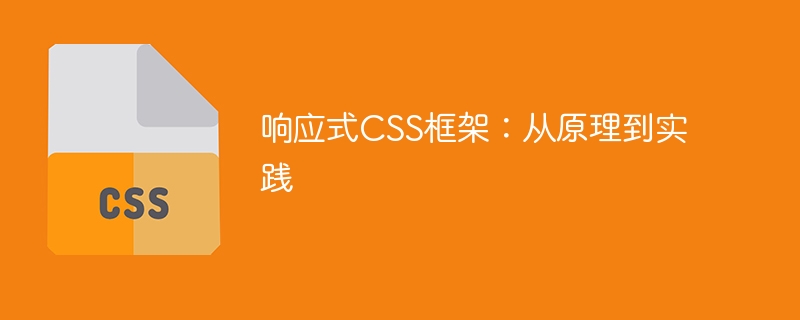

Responsive CSS framework: from principle to practice, specific code examples are required
Introduction:
In today's mobile Internet era, more and more users use Browse the web on mobile devices. To provide a better user experience, developing responsive web design becomes crucial. The responsive CSS framework is a powerful tool for implementing responsive web design. This article will introduce the basic principles of the responsive CSS framework from principle to practice, and give some specific code examples to help readers better understand and apply the responsive CSS framework.
1. The concept of responsive CSS framework
The responsive CSS framework is a CSS development framework used to create web pages that can adapt to different screen sizes. By using technologies such as media queries and elastic layout, responsive CSS frameworks can automatically adjust the layout and style of web pages based on the different characteristics of the device.
2. The principle of responsive CSS framework
Sample code:
/* 当屏幕宽度小于768px时,应用这些样式 */
@media (max-width: 767px) {
body {
font-size: 14px;
}
}
/* 当屏幕宽度在768px和1024px之间时,应用这些样式 */
@media (min-width: 768px) and (max-width: 1024px) {
body {
font-size: 16px;
}
}
/* 当屏幕宽度大于1024px时,应用这些样式 */
@media (min-width: 1025px) {
body {
font-size: 18px;
}
}Sample code:
.container {
display: flex; /* 设置容器为弹性布局 */
flex-wrap: wrap; /* 当容器宽度不足时换行 */
}
.child {
flex: 1; /* 设置子元素均分剩余空间 */
min-width: 300px; /* 设置子元素的最小宽度 */
}3. Practice of responsive CSS framework
Sample code:
<!DOCTYPE html>
<html>
<head>
<link rel="stylesheet" href="https://cdn.jsdelivr.net/npm/bootstrap@4.5.2/dist/css/bootstrap.min.css">
</head>
<body>
<div class="container">
<div class="row">
<div class="col-sm-4">
<p>内容1</p>
</div>
<div class="col-sm-4">
<p>内容2</p>
</div>
<div class="col-sm-4">
<p>内容3</p>
</div>
</div>
</div>
</body>
</html>Sample code:
<!DOCTYPE html>
<html>
<head>
<link rel="stylesheet" href="https://cdnjs.cloudflare.com/ajax/libs/foundation/6.6.3/css/foundation.min.css">
</head>
<body>
<div class="grid-x">
<div class="cell small-4">
<p>内容1</p>
</div>
<div class="cell small-4">
<p>内容2</p>
</div>
<div class="cell small-4">
<p>内容3</p>
</div>
</div>
</body>
</html>Conclusion:
The responsive CSS framework is an important tool for implementing responsive web design. By using technologies such as media queries and elastic layout, it can automatically Adapt to the needs of different screen sizes. This article introduces the basic principles of the responsive CSS framework and gives some specific code examples, hoping to help readers better understand and apply the responsive CSS framework. By using responsive CSS frameworks, developers can quickly build web pages that adapt to different screens and provide a better user experience.
The above is the detailed content of From Basics to Practical Applications: Understanding the Responsive CSS Framework. For more information, please follow other related articles on the PHP Chinese website!




